Prism’s Auras
Introduction
Hello Flesh and Blood community! It has been almost one week since the release of Monarch First Edition and I hope that the FAB-boosterpack-Gods have blessed you all with the cards you wanted. I am sure many of you are already tinkering and building new decks during your free time, so I expect to see many new and interesting brews in the Blitzed event of May! This time there will be a whopping 21 participants battling to get a much desired spot in the Hall of Fame. This surely will be an amazing tournament!
It are times like these that I enjoy a card game the most. I’ve always really loved building decks; discovering synergies and interactions between cards, learning a deck in- and out and making improvements, step by step. Flesh and Blood really is an incredibly good game if you love building a custom deck to your own liking.
I always want to play a deck/hero that is not played by the majority of players; something not on the top of the hierarchy, such as Ira and Dora were before. However, during spoiler season I was really conflicted! I heard many people talking about Prism, which was definitely the most hyped hero of Monarch. However, I have always been a huge fan of angels (which Prism uses a lot), I even used to collect them in another card game (you might have heard of Magic the Gathering). Eventually my love for angels won from my wish to play something underrepresented. But while building my first Prism deck, I had a heart-warming revelation: I noticed just HOW well designed and diverse this class truly is! Great news, this means we get to be really creative and design around our own playstyles and preferences even within a class more than ever. If this is true for all of the Monarch classes, this game will surely convince many players just how good FAB is, and will catch the attention of many new players as well!
Illusionist Auras
In this article I’d like to write something about the Light Illusionist – Auras in particular. But first a quick disclaimer: I am not an expert on this topic, but I’ve looked into it as I intend on playing Prism A LOT, and I would like to share my views and thoughts with you and the FAB community. All of this content is open for discussion and I encourage you to leave a comment below.
There are five different illusionist auras available: Arc Light Sentinel, Genesis, Parable of Humility, Merciful Retribution and Ode to Wrath. The goal of these Auras is to make good use of their abilities and keep gaining advantages until your opponent has had enough of it and decides to destroy it at the cost of an attack (without triggering Go Again).
All these auras can be played on instant speed, and it is important to know when you can play them. I copied this from the LSS Monarch Release Notes: “You may play an Instant – Aura any time that you have priority. The first opportunity on your own turn is on your action phase and the first opportunity on your opponent’s turn is on their action phase after they are passed priority (Usually by playing a card or passing priority after electing not to play a card)”.
However, there are some obvious drawbacks to these auras: In addition to their high cost, it is also important to note that all of these auras have NO defense value. So while there might eventually be a really cool deck full of yellow and blue pitch cards and a full set of all auras supporting a Spectral Token beatdown strategy, I expect most of the Prism decks won’t use all of them (as it would mean 10 for blitz or 15 for CC). In Blitz, I chose a couple for the initial draft of my deck (currently 2 copies of 2 auras), and this choice determines the deck’s playstyle somewhat and it increases the powerlevel and utility of some cards. The auras will give a deck what you could call character, flavour or identity. On the other hand, in Classic Constructed where you can bring more cards, you can adjust your deck to counter the gameplan of your opponent and play different auras and matching cards for different matchups. This is something I am really looking forward to!
Parable of Humility (PoH)
Attack action cards controlled by an opposing hero have -1A while attacking and defending. This card straight up makes attacks with Phantasm better, and it is good against decks that care about to-hit effects and/or chaining multiple attacks with Go Again. Moreover, in general most players choose to play attacks with 4, 5 or 7 attack, because they would be more difficult to block by regular cards that have a defense value of 3; always forcing an unfavourable block or sneaking through a little bit of damage. Parable of Humility stops this nonsense immediately, unless your opponent chooses to attacks it directly, which is still positive, because that also prevents on-hit effects to trigger and you won’t lose life. As mentioned before, PoH makes your Phantasm cards less susceptible to destruction, as it would now require an attack with a base value of 7 (or 8 if you have two in play). Naturally this is good for Herald of Protection (Red) due to its big On-Hit effect to potentially force a block of three cards (or you’ll get a Soul and a Spectral Shield token). But PoH especially favours Herald of Tenacity and Herald of Erudition in particular, which both have Dominate AND Phantasm. The dominate effect on these cards usually isn’t as strong as it is on cards without Phantasm, due to the option of being destroyed with one card anyway. Take that away and you have some powerful cards that will surely give you card-advantage. Parable of Humility shines the brightest in the matchup against Brute by far, so it will be a good CC inclusion to use when facing Levia, Rhinar and the likes.
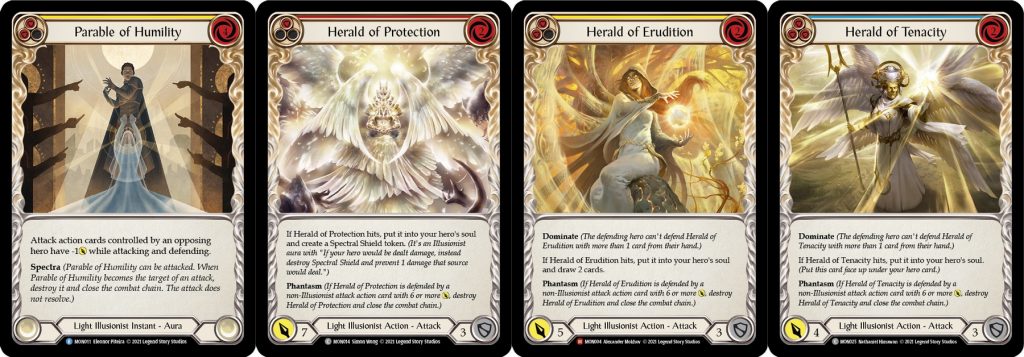
Genesis
This aura has card-advantage written all over it. Every turn you’ll gain a soul, a spectral shield AND draw a new card, provided you can offer it a Light Illusionist card. Card-advantage, card-advantage, card-advantage. This is incredibly strong and will surely provoke your opponent into attacking it. Remember you’re not allowed to play Instants at the end of your opponent’s turn, as you don’t have priority at that time, but you can play it in response to their attack so you’ll still have it at the start of your turn. Timing a good Genesis is crucial however, as it requires a full hand to play it and utilize its effect immediately: Pitching two cards to cast it, Genesis itself is a card, in addition to the card required to put into your soul. This means it is even more ‘costly to cast’ than the other auras. You could find a moment to do so when you are ahead, as your opponent will have few or no cards in hand, resulting in an unimpressive turn. But by casting Genesis afterwards, you are giving your opponent an opportunity to get back into the game, allowing them a full set of cards in hand because you didn’t keep up the pressure by a big attack. So I believe the best times to cast Genesis are: on your first turn, during your opponent’s first turn, when you have it in arsenal, or when you can get an extra resource from Fyendal’s Tunic or the Vestige of Sol. The ability to get a card into your soul at no cost of cards is very good in general, but makes the Vestige of Sol a lot better in particular, as well as it makes the Tome of Divinity playable. Now, just imagine the sweet sensation of combining these three cards. When you start your turn with Genesis still in play, putting a card in soul from its effect and drawing a card, pitching a Blue card for four resources, playing Tome of Divinity to draw 3 cards… Card-advantage. You could then continue to cast more Auras at the ‘cost of only one Blue card’ each, or create more additional Spectral Shield tokens, add a Glisten for several +1 attack counters and have a really scary boardstate. This could actually make the deck with all auras possibly playable, if there are more cards besides Soul Shield (and Arc Light Sentinel) to cover the weakness of having no defense. Alright, let’s say you are like me and don’t have a Vestige of Sol and you have no desire to play the Tome because it more often is a burden than a benefit, let’s say you play a well timed Genesis and follow it up with a Glisten from arsenal to immediately give the freshly created Spectral Shield token three +1 attack counters. Will your opponent attack Genesis, or attack you, trying to get rid of the token with 4 attack (assuming you’re playing Luminaris)?
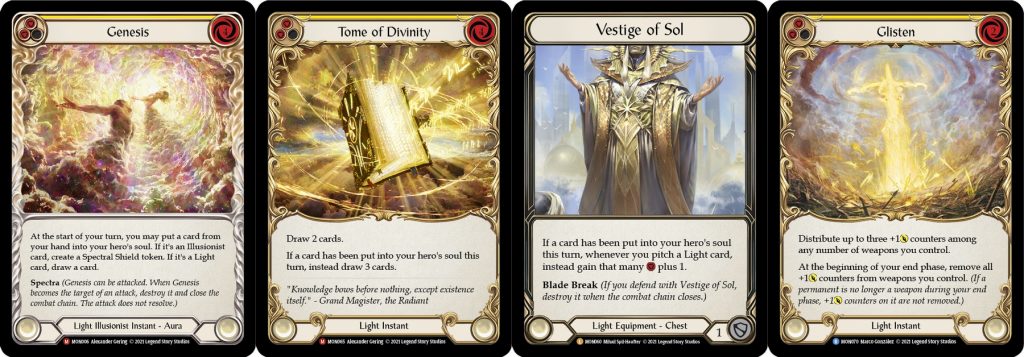
Merciful Retribution (MR)
Whenever a Spectral Shield token is destroyed, MR will deal 1 arcane damage in addition to the damage prevention. Whenever one of your Phantasm attacks ‘fizzles’, MR will deal 1 arcane damage. Whenever another aura, or Merciful Retribution itself is destroyed, MR will deal 1 arcane damage. This damage will surely add up when Merciful Retribution remains unchecked. And moreover, if the destroyed aura or attack was of the Light talent, the card will be put into your soul! Imagine having a couple of Spectral Shield tokens out, while being attacked. You can drop MR into play, and deal surprise damage to your opponent. The next part might be a little bit Farfetch’d (#83) as it’d need the perfect hand and isn’t necessarily better than just attacking, but if they leave it in play (since your board is empty anyway) and choose to attack you again on their next turn you could go for it. Using a counter from Tunic and two cards generates 7 resources: which is enough to cast both Prismatic Shield (3) and a second Merciful Retribution (4). Two or three tokens (yellow or red respectively) would mean four to six arcane damage, on top of the damage prevention. A very situational, planets need to be aligned, kind of scenario, but it clearly illustrates the potential of a Merciful Retribution. While on the other end of the spectrum, without aligning planets, just ANY possible situation, it always replaces itself when destroyed: 1 damage and one soul. This is what I mainly like about it, because in any given situation it will be either a threat or make value by eating an attack and still fuelling your soul and dealing 1 arcane damage. And like Parable of Humility, MR also helps your attacks to be useful: which will also still deal a little bit of damage when destroyed (blocked by a 6 power attack) and fuel your soul, in case of a Light attack.
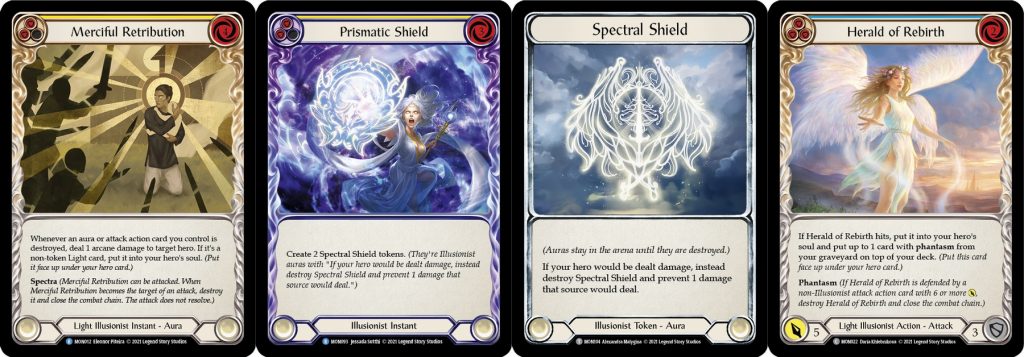
Ode to Wrath (OtW)
The most direct offense-oriented card out of the five auras. Whenever a source you control deals damage to an opponent, they lose one additional life. A pretty straightforward use would be to combine it with some Luminaris fuelled “kodachi” stabs from several Spectral Shields, the more the merrier! Ode to Wrath is also good in combination with a follow up of a well-timed Merciful Retribution when these “kodachi’s” are being destroyed. While it is definitely a strong addition to the aura and shield line-up, your attacks that hit are also resonating with this card, but one Light Illusionist attack is benefiting this effect in particular: Herald of Ravages. When it would deal damage, the opponent will be dealt 1 arcane damage, which means it will trigger Ode to Wrath twice. The second effect of OtW is that your attack action cards get Go Again. While this mostly looks like just a nice bonus effect and even is partially overlapping with Luminaris effect, it can be totally devastating against decks with only a few 6-power attack cards when you chain two big attacks per turn. Herald of Triumph and Phantasmaclasm are attacks that are less prone to be destroyed, which means they are better targets to give Go Again, Parable of Humility can also help other attacks to get on this level.
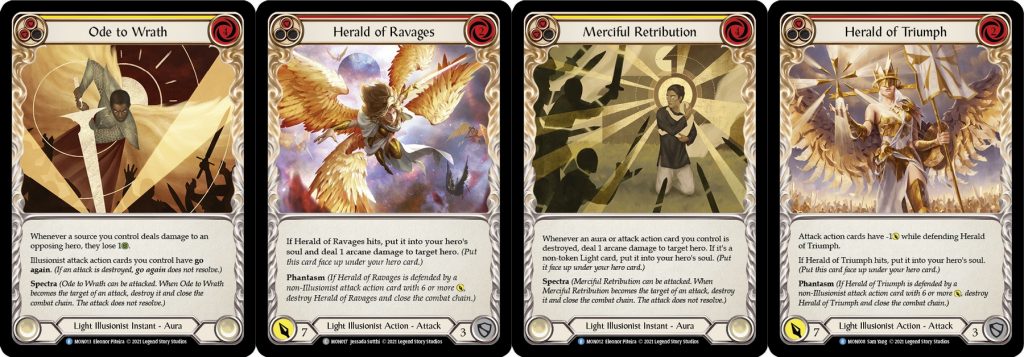
Arc Light Sentinel (ALS)
I’ll be honest with you: I was not impressed by the sight of Arc Light Sentinel at first, but regardless of the steep cost of 6, this card is probably the closest we’ll ever get to a Timewalk. If ALS is in play, your opponent must choose it as the target of their attack. And when it becomes targeted, their attack ‘fizzles’ like a Phantasm attack; it does not resolve and the combat chain will be closed. You do not have priority at the start of your opponents turn, but when they play a non-attack Action to increase the damage on their next attack, you can whipe that smirk of their face by slamming this big boy in reaction: They will have to attack ALS with the supersized attack and it will not have Go Again triggers. If they start their turn with an attack action however, you can not respond with ALS to redirect the attack to it. The cost of 6 means this card requires at least three cards from your hand (itself included), leaving you with 1 card if you’re playing enough BLUE pitch, or potentially 2 if you have something stored in Arsenal. This could mean a timewalk and playing a free 0-cost attack (such as Illuminate) or a potion, putting a card in arsenal, creating a Spectral Shield from Prisms ability or playing a really good stashed card from arsenal to push the tempo. Imagine pitching two blue to ALS their big turn, and pitch a yellow to play a 2-cost attack afterwards (attack for 7). But moreover, it is keeping your little Spectral Shield friends and other Auras safe for another turn, which could translate to a bunch of “Kodachi” damage in a deck with Luminaris or even more if a Glisten resolved earlier. Another turn also means another Genesis trigger, and with the additional resources from Vestige it becomes quite affordable. Of course using THREE cards to stop a turn should not be used lightly. Normally these three cards would block for a total of around 9, so your opponent’s turn has to be really devastating or crucial. The difference is that with ALS you’re putting two cards on the bottom of your deck (pitched), and are allowing to use 0 defense cards to still stop damage. Because Arc Light Sentinel is so much better when you’re ahead, and probably not as useful when behind, it is helpful that the first line of text on it says “Prism Specialization”, which means it can be searched for after creating several Spectral Shield tokens (which is when it is needed), using the Mentor card The Librarian. However I am still not sure what ALS’ spot will be in decks; anything from auto-include to a situational one-off or ‘too expensive to play’. But I am sure of two things: While the other auras have a conditional “taunt” mechanism and will be attacked only when the opponent dislikes its effect, ALS has a “taunt” of 100% and seems like a good follow up to Towering Titan from Bravo or a Bloodsheath Skeleta into Sloggism from Viserai.

Concluding words
It is exciting to see the evolution of the game and to experience the new angles and playstyles from different heroes. Every class already felt like you’re playing a different game, as it brings completely different possibilities for deckbuilding and gameplay. Some heroes/classes were figured out by the community, and were usually played with almost identical decks with only a little variation, some heroes had two different builds. But now it is time for a complete divergence of the spectrum; I feel like decks of the same hero will be very different from each other. Specially in Classic Constructed where there’s the extra dimension of being able to bring additional cards. Changing a part of your deck and equipment really gets more and more interesting the better you understand the other classes, their mechanics and different possibilities. Illusionist surely has some strong and impactful cards that can change its strategy completely. I really love the design of these cards. It was the artwork that got me into this class, but the options and possibilities will keep me here for a while.
Thank you for reading,
Take good care of yourself,
and good luck & have fun in the current Blitzed tournament!
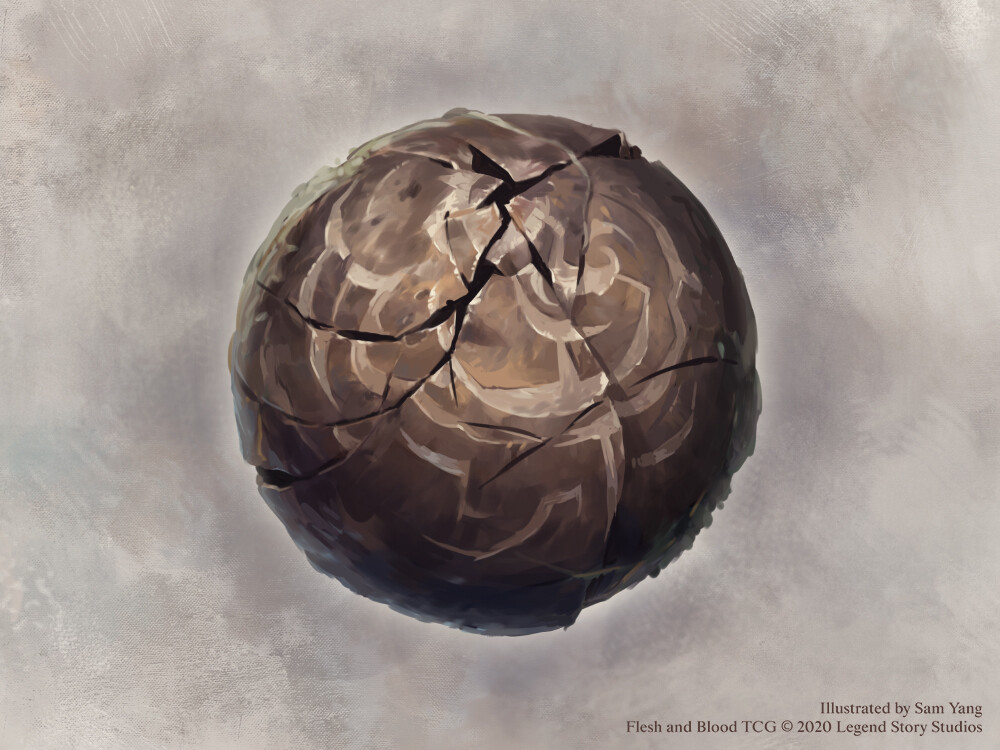
Community Feedback
Some readers pointed out things I missed or that they disagreed with.
Jonathan from our local group pointed out that Genesis + the Illusionist Mentor is incredibly powerful, as you’d get a token at the start of your turn which means the extra card from The Librarian.
A player from the “Flesh & Blood TCG – Community” group on Discord, with more play-testing experience in the CC format, mentioned that the Parable of Humility (the aura that gives -1A) might not be as good against Brute as I thought, due to the extra action points they can generate.